MAKING THE ROTARY VALVE!!
Making the rotary valve for this steam engine. The photo below shows the blue print of the rotary valve for this engine.
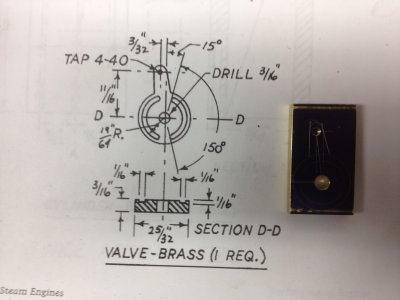
The plans call for 3/16 x 25/32 brass. I have a 1/4 x 1-1/2 bar so thats where I started.
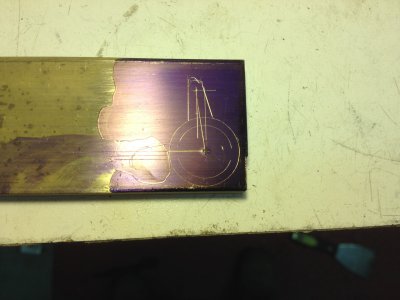
I Dykem blued the bar in the picture above, punched a mark for the main hole and scratched the rough outline of the part.
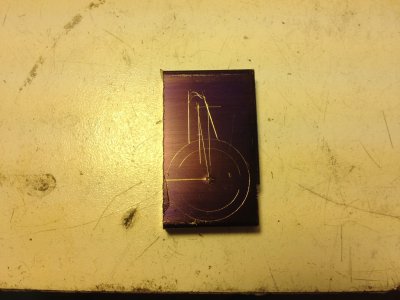
Above I cut the part off the bar with my HF 4x6 band saw.
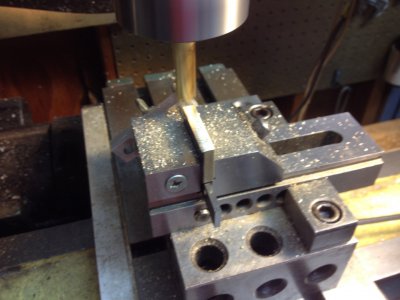
In the picture above I took a cut across one side of the part, then I flipped the part over and made the same cut on the other side so the two sides would be parallel for the next step.
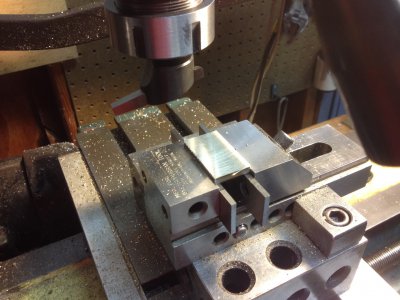
As shown above, I used my fly cutter to cut the thickness down closer to 3/16". I took the part out of the vice and miked it and it was .205" thick.
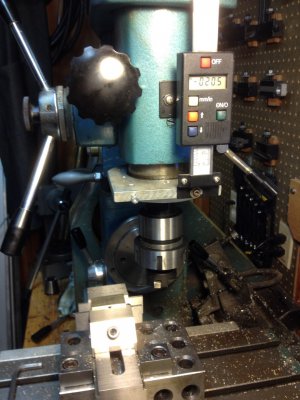
So I set my high dollar Z axis DRO to -.205" and I took another pass or two with the fly cutter until the DRO read -.1875, which is the desired thickness.
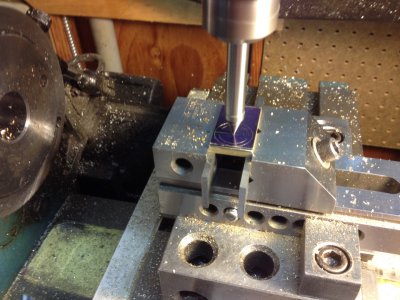
I used my edge / center finder in the punch I made to locate the center of the main hole. I have to move the vise to the left and a little bit away from the camera.
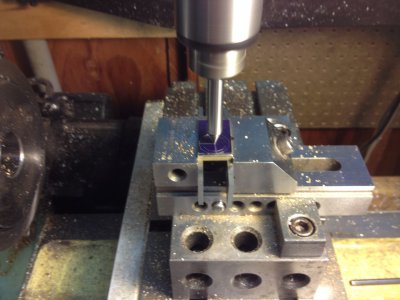
There we go, pretty well lined up.
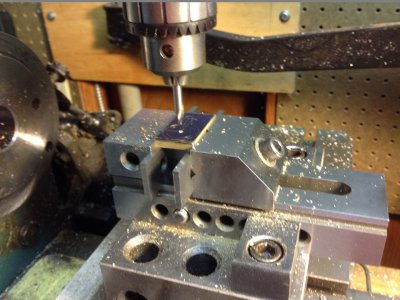
Probably could have just drilled with the punch mark, but force of habit, I center drill first.
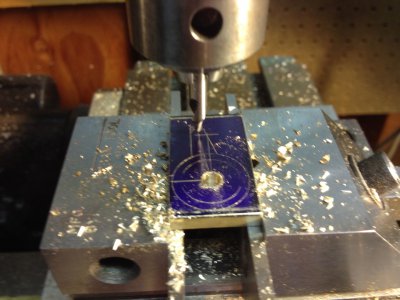
The photo above, I already drilled the 3/16 main hole. I move the vise to the right 3/32" and toward the camera 11/16 to locate the hole that is tapped 4-40 on the end of the arm. This hole is to connect the eccentric arm that will rock the valve back and forth to control the passage of steam to the top and the bottom of the cylinder and out the exhaust port.
I looked on my drill tap chart and picked the right drill.
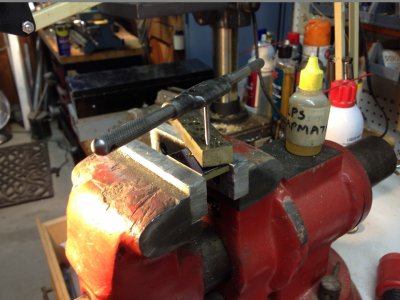
I tapped the 4-40 hole using a homemade tap guide because I find I get the hole perpendicular and I break fewer taps.
At this point the part is at the stage shown in the very first picture above.
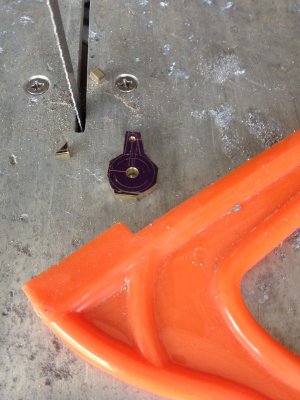
Now I convert my HF bandsaw to a vertical saw and remove a bunch of the excess material. The plastic dohickey is for my table saw, but I like to use it here too, because cuts into it are less painful than into my fingers.
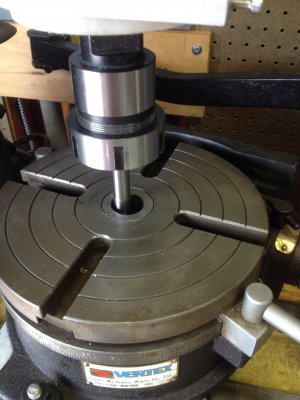
Okay, so above I bolted my rotary table to my milling machine and I use an edge finder and my DRO to locate 0,0 or the center of the table.
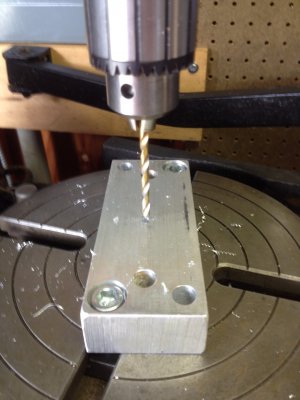
Above I have bolted a piece of aluminum bar to the table and I drill a hole for a 10-32 screw here at what I think is 0,0.
(see below I think I blew it slightly here or the step above)
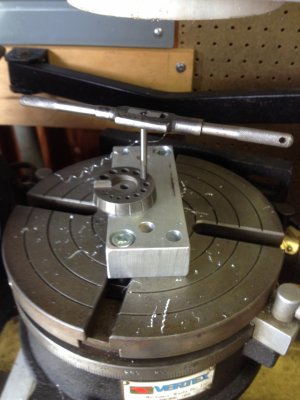
Taping the 10-32 hole. then I again moved over 3/32 on the x axis and 11/16 on the Y and drill a whole just large enough that a 4-40 screw will just fit.
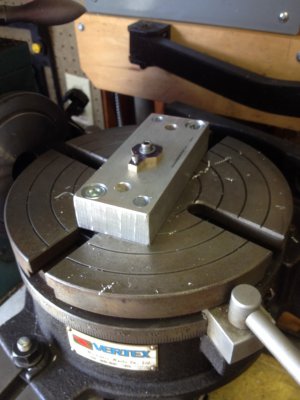
Above the valve blank is screwed down to the rotary table and ret 2 go.
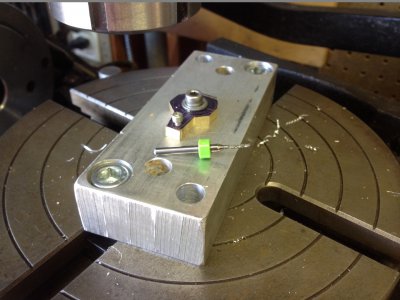
I decided to mill the two 1/16 x 1/16 x 150 degree slots in the valve first. I have these 1/16" burrs that I think are for a Dremel as shown above with the green collar. I've had a heckuv a lot better luck with these than 1/16 end mills and thank God we are milling in brass. They might be carbide because they are harder than woodpecker lips. I put my mill on the fastest speed it will spin.
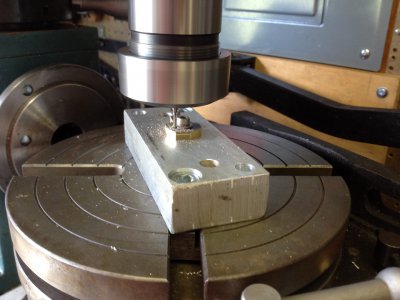
Here we go! Above I plunged in .015" and swept an arc from 15 degrees to 165 degrees. So, I swept, went down another 15 thou etc until I was .062 deep. I just felt that going 62 thousands in one pass would be pushing my luck and would snap off the end of that burr. Then I did it again on the other side 345 - 195. With 20-20 hindsight and looking at the plans again, I should have maybe not swept that long of an arc. Rudy's plans show the end of the cut at 15 and 165 degrees NOT the center of the 1/16 end mill like I did it. So my slots are a little longer than they should be. But, I don't think, and I hope, this won't make any difference in the operation of the valve and the engine.
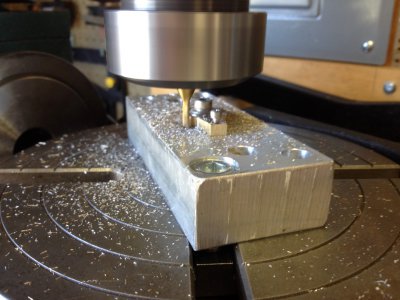
In the photo above, I have installed a 1/8 end mill and moved more than one half of 25/32nds away from center PLUS one half of the diameter of the cutter. I went down until I am just barely cutting the aluminum base. I am sweeping around the part with the rotary table to create the circular shape of the part. I carefully watch the lines I scribed in the Dykem when I get close to the arm part so I don't cut into that or cut it off! I move closer to center and sweep again etc. I stop when I am one half the diameter of the part PLUS one half the diameter of the cutter away from the center.
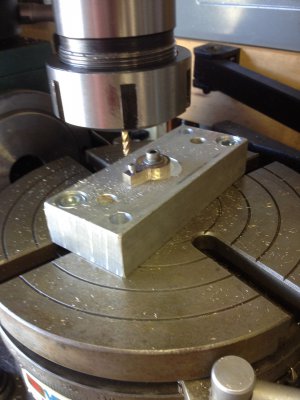
Next I figured out that the left side of the ARM of the part is cut by moving 3/32 + 3/32 PLUS half the diameter of the cutter (.250) away from center on the X axis and a straight shot down the Y to .378 (Using trig, a right triangle, hypotenuse is .453 the opposite side is .250 the adjacent side has to be .378! And you thought you would never use high school math!)
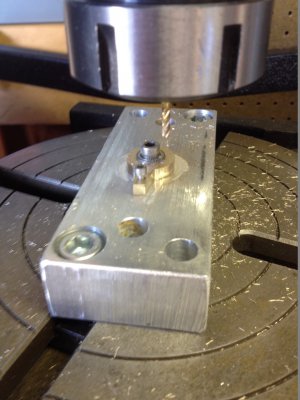
How do I get the sides of the arm to be mirrors of each other and not have to further fry my brain doing the math???
Take the part off and flip it over and screw it down. Take the same cut as above!! Ta Da!
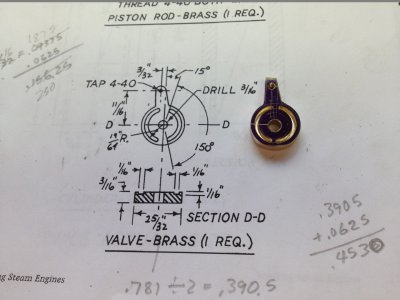
So now the part looks as shown above. Do you see the problem I mentioned earlier? I did not see it yet. I took the part over to the handy dandy belt sander and carefully radiused the top of the arm.
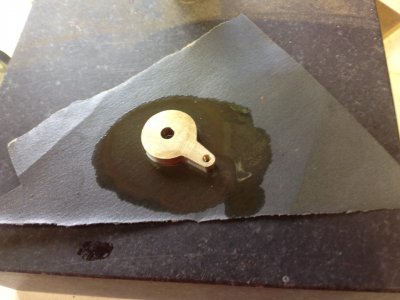
Now I put a piece of 400 grit wet or dry sand paper on a flat surface and I put a drop of cutting oil on it. I carefully lapped the face of the part by going in little figure 8s with my fingers. This is to deburr it and make it smooth and flat so it will seal as best as possible with the valve port face. NOW is when I see that the goll darn main hole is not in the center of the part. I was cussing like a sailor! How the heck did that happen! I thought, I have to start ALL OVER again! I turned off the lights, closed the shop and left disgusted with myself.
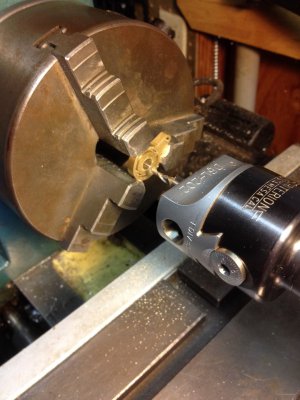
Away from the shop for a while and I have an epiphany. I decide to BORE the hole out larger and make a sleeve to fit in the hole to bring it down to the right size! I carefully chuck the part in my three jaw chuck. I put a parallel bar on the bottom two jaws and pressed the valve against the parallel as I tightened the chuck. I removed the parallel. I used a dial indicator to make sure it was true. I used one flute of a two flute 1/8" end mill as a boring bar. I put my boring head in the tail stock of the lathe. By adjusting the boring head I slowed bored that sucker out until it was .250.
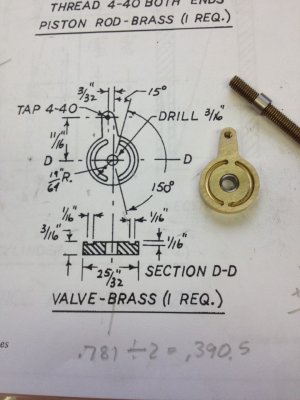
Above you see the completed part, warts and all. I made a little sleeve from .250 stainless steel (303). The valve rotates around a 10-32 brass stud as also shown above. My accidental redesign may turn out to be a good thing. I made a second ss sleeve that is threaded on the rod in the picture. I may use this sleeve so that the bearing surface is the stainless against the hole in the center of the valve. A bearing surface of stainless against brass wears well in my experience. This is opposed to the brass valve wearing against the brass threaded stud in the original design. So, the slots are a little long and the distance from the center of the main hole and the center of the hole in the arm is maybe .015 too short, but my educated guess is that it will work!! We shall see!
Best Regards --- Dave



















































